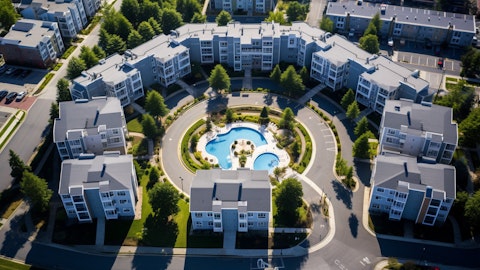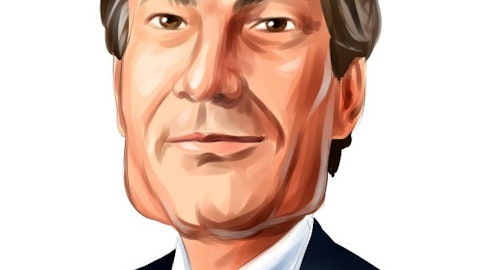CBRE Group, Inc. (NYSE:CBRE) Q4 2023 Earnings Call Transcript February 15, 2024
CBRE Group, Inc. beats earnings expectations. Reported EPS is $1.38, expectations were $1.21. CBRE isn’t one of the 30 most popular stocks among hedge funds at the end of the third quarter (see the details here).
Operator: Hello, and welcome to the CBRE Q4 2023 Earnings Conference Call and Webcast. [Operator Instructions] As a reminder, this is being recorded. It’s now my pleasure to turn the call over to Brad Burke, Head of Investor Relations and Treasurer. Brad, please go ahead.
Brad Burke: Good morning, everyone, and welcome to CBRE’s Fourth Quarter 2023 Earnings Conference Call. Earlier today, we posted a presentation deck on our website that you can use to follow along with our prepared remarks, and an Excel file that contains additional supplemental materials. Before we kick off today’s call, I’ll remind you that, today’s presentation contains forward-looking statements, including without limitation statements concerning our economic outlook our business plans and capital allocation strategy and our financial outlook. Forward-looking statements are predictions, projections or other statements about future events. These statements involve risks and uncertainties that may cause actual results and trends to differ materially from those projected.
For a full discussion of the risks and other factors that may impact these forward-looking statements, please refer to this morning’s earnings release and our SEC filings. We have provided reconciliations of the non-GAAP financial measures discussed on our call to the most directly comparable GAAP measures, together with explanations of these measures in our presentation appendix. I’m joined on today’s call by Bob Sulentic, our Chair and CEO; and Emma Giamartino, our Chief Financial Officer. Now, please turn to slide 5, as I turn the call over to Bob.
Bob Sulentic: Thank you, Brad, and good morning, everyone. CBRE ended 2023 on a high note with fourth quarter year-over-year operating profit growth across all three of our business segments. Even though 2023 was a difficult year for commercial real estate, we delivered the third highest full year earnings in CBRE’s history as our resilient businesses continued their strong growth. This partly offset market-driven revenue declines in businesses that are sensitive to interest rates and debt availability. Emma will talk about our resilient businesses in greater detail at the beginning of her comments. We are committed to driving significant gains in all of our businesses with a particular focus on through-cycle resiliency and double-digit compound long-term earnings growth.
Two recent wins highlight our progress. First, with the acquisition of J&J Worldwide Services and our GWS segment, we will increase our technical services capabilities for US federal government clients and open a mostly untapped channel in a difficult to penetrate market. This is a large market characterized by steady growth and long-term contracts. Second, our strategic partnership to provide property management services for Brookfield Properties, 65 million square foot US office portfolio is among the largest in the history of our sector. We believe there will be more opportunities of this nature, which we are well positioned to capture. We start 2024 with strong new business pipelines across our company. We also see attractive M&A and REI co-investment opportunities.
Investor and lender sentiment has improved and we anticipate this will lead to increased transaction volumes, starting in the second half of the year when short-term interest rates are expected to fall. Against this backdrop, we expect to achieve core EPS of $4.25 to $4.65 in 2024, implying mid-teens percentage growth at the midpoint of the range. This broad range reflects the difficulty in predicting the precise timing of a recovery. It is notable that any outcome in this range would still be well below the long-term earnings potential of CBRE. With that, Emma will walk you through our results and outlook in more detail.
Emma Giamartino: Thanks, Bob. Before turning to segment performance, please turn to Page 6, as I provide more insight into our resilient businesses. We’ve used this term regularly in our earnings calls over the last several quarters and it is now being used broadly in our sector. CBRE defines resilient businesses, as those which hold up well in a down market cycle, either because of their noncyclical characteristics or because they benefit from secular tailwinds. For CBRE, those businesses include the entire GWS segment, loan servicing, valuation, property management and recurring asset management fees in our investment management business. When we use this term, this is the group of businesses we are referencing. These resilient businesses in aggregate generated nearly $1.6 billion of SOP in 2023 and are expected to generate $1.8 billion of SOP in 2024.
This would represent a sixfold increase from 2011, the first full year of market recovery following the global financial crisis. We expect 2024 to be the beginning of a market recovery, albeit a more gradual one. For context, our resilient businesses have grown SOP over 3x as fast as our transactional businesses, since 2011 and they are expected to be nearly double the size of our entire business at a similar point in the last cycle. Please turn to Page 7, as I review our results and outlook for 2024. Across the advisory segment, net revenue and SOP essentially matched the prior year’s Q4. Leasing saw a slight uptick in revenue for the quarter driven mostly by EMEA and APAC. Globally, higher office leasing offset slightly less industrial activity.
Within property sales, industrial and retail declined less than multifamily and office, supported by healthy fundamentals. Commercial mortgage origination revenue growth was attributable to interest earnings on escrow balances. The rest of our advisory business lines together achieved a 6% net revenue increase. Turning to Page 8. GWS had another strong quarter. Net revenue and SOP grew by double-digits. Facilities Management net revenue increased 14% for the quarter and 13% for the year. Most significantly, our sizable GWS local business has been increasing net revenue at or above a mid-teens clip, and is well positioned to sustain this growth rate for the long term. Project Management net revenue grew 11% for the quarter and 14% for the year.

This was led by the large-scale program management work being done globally by Turner & Townsend. Notably, we had record pipeline conversion to new GWS contracts during Q4 with a balanced mix of new clients and existing client expansions. Turning to Page 9. SOP in our REI segment increased to $68 million in Q4, up from just $17 million in the prior year Q4. Development exceeded expectations due to the earlier than anticipated monetization of several assets in the US. Investment Management operating profit rose significantly in Q4, driven by higher incentive fees and recurring asset management fees. Investment management AUM ended 2023 at $148 billion, up $3 billion for the quarter, largely driven by favorable currency movement and modest net capital inflows, which offset lower private asset values.
For the year, AUM was down $2 billion. While exit value declines appear to be slowing, we anticipate values will remain under pressure in early 2024. Before turning to our 2024 outlook, I’ll comment on our capital allocation strategy on Slide 10. We are on track to deploy more than $2 billion of capital for the 12 months ending Q1 2024. This deployment includes M&A, mostly in our resilient businesses and a record level of co-investment commitments in REI. By thoughtfully using our balance sheet we made targeted opportunistic investments, while other investors have been largely on the sidelines. These investments have been underwritten at returns, well above our cost of capital. And specifically, our REI investments are projected to generate notably high returns.
We also repurchased nearly 8 million shares in 2023 at a time when we believe they have been attractively valued. Our 2024 capital deployment will be supported by improved free cash flow, which we expect to total at least $1 billion, as certain headwinds reversed this year. As we’ve previously discussed, we had several large cash expenses in 2023 mostly timing-related items, such as cash variable compensation and cash income taxes tied to 2022 record results that did not flex down with last year’s lower earnings. We estimate that the reversal of these items alone will drive a $500 million benefit to free cash flow compared with last year. Taking all of this into consideration, we expect to end 2024 with net leverage around one turn. Now I’ll review our 2024 outlook on Slide 11.
In the advisory segment, we expect net revenue to increase by mid- to high single-digits, with mid-teens SOP growth. The expected margin improvement reflects fixed cost leverage and the benefit of ongoing cost reduction initiatives. Advisory accounts for about two-thirds of the $150 million run rate cost savings initiative announced last quarter with half of the benefit being realized in 2024. These savings offset cost growth elsewhere in advisory this year notably from higher expected discretionary compensation tied to improved financial performance. We anticipate that capital markets revenue will grow by mid-single digits. Investor sentiment has improved in the last nine days, reflecting a better interest rate outlook. Real estate allocations are approaching target levels and this reflects an easing of the denominator effect, as public equity markets have rebounded while private relist values are being written down.
We expect leasing to grow modestly in 2024. We are cautiously optimistic that the worst is over for office leasing, particularly for Class A properties, where we generate approximately two-thirds of leasing revenue. Leading indicators from our data partner VTS indicate US office demand has been gradually turning up over the last six months. The growing consensus about an economic soft landing coupled with the apparent stabilization of office utilization rates may make more employers confident enough to commit to office leases. Additionally, leasing demand should remain relatively strong for industrial deals particularly for properties under 500,000 square feet. Our remaining advisory business lines together are expected to achieve low double-digit net revenue growth.
In the GWS segment, we expect mid-teen SOP growth including the expected partial year contribution from the J&J acquisition. Continued strong organic growth will be driven by broad demand across client sectors and geographies. The local business will lead growth in GWS expected to generate more than $200 million of operating profit as we benefit further from our investments in this business. Our enterprise business is also seeing strong demand from both mature sectors like financial services as well as newer adopters of outsourcing such as industrial, healthcare and life sciences companies. Within project management significant growth will be led by Turner & Townsend, which is in the early stages of penetrating the US. market. We anticipate seeing most of the revenue impact from our sizable Q4 wins in the second half of 2024 as new clients are onboarded.
And even with the record level of conversions in Q4 our GWS pipeline ended 2023 10% higher than the prior year. Shifting to REI. We expect SOP in 2024 to be slightly below 2023’s level. Note that last year’s SOP included a single development portfolio sales, which generated more than $100 million of profit in Q1. In Investment Management, we expect operating profit to increase modestly from 2023 as stabilizing market conditions drive higher promote fees and improved co-investment returns. We expect development operating profit will be subdued this year as the projects we expect to monetize will be sold at higher cap rates than we underwrote at the peak of the prior market cycle. At current market cap rates we have hundreds of millions of dollars of operating profit embedded in our in-process portfolio and a pipeline of new opportunities with an attractive spread between our cost of development and current market value.
On balance, we are cautiously optimistic about 2024. Our expectation of achieving core EPS of $4.25 to $4.65 is contingent on long-term interest rates remaining around current levels the Fed proceeding with the anticipated short-term rig cuts and the US economy avoiding a recession. This year’s earnings are likely to be more heavily weighted than usual to the second half. The third and fourth quarters are expected to account for approximately two-thirds of our EPS while the first quarter will contribute a mid-teens percentage of the annual total. This distribution is similar to what we experienced in 2021 when we also had a second half recovery. We continue to see a path to returning to our prior core PS peak in 2025. That path is supported by continued double-digit growth in our resilient businesses and a gradual recovery in our transactional businesses.
Importantly, CBRE can reach prior record earnings without our transactional businesses SOP rebounding to 2019 levels. With that operator, please open the line for questions.
See also Top 12 Retirement Savings Tips for 55-to-64-Year-Olds and 13 Best NASDAQ Penny Stocks To Invest In.
Q&A Session
Follow Cbre Group Inc. (NYSE:CBRE)
Follow Cbre Group Inc. (NYSE:CBRE)
Operator: Thank you. We will now be conducting a question-and-answer session. [Operator Instructions] Our first question is coming from Anthony Paolone from JPMorgan. Your line is now live.
Anthony Paolone: Okay. Thank you. Good morning. I guess, my first question is I look at the guideposts for the various business lines. They seem kind of pretty good from our vantage point. But just wondering if you could talk about things like the corporate segment taxes, interest expense creation all that sort of other stuff and any year-over-year drags or ability to quantify any notable drags from those items as we think about going down to EPS.
Emma Giamartino : Yes, Tony. So, first to step back on our outlook just give context around the range, which I think will help get to the corporate and below the line items. If you look at our segment level guidance, I think, what you’re seeing is that you likely get to an EPS that’s slightly above the midpoint of our range. And what we baked into the midpoint of our EPS guidance is some level of conservatism, given that rates have continued to bubble especially in the past few weeks. So it’s safe to assume on the corporate cost level the corporate segment level that is going uptick slightly, but not as much as your — the number that you’re looking at might imply. And the reason corporate will uptick slightly is because primarily, because our bonuses discretionary compensation will reset to levels that are in line with improved financial performance.
And then I’ll comment on the range of our outlook. The pieces that we have a high level of conviction around is our growth in our resilient SOP. We talked about that growing from $1.6 billion this year to $1.8 billion next year or 2024 and that’s consistent across the range. And then our transactional business lines are clearly the ones that will move us towards the bottom end or the high end of the range depending on when the recovery begins.
Anthony Paolone : Okay. Thanks. That’s helpful. And then just in terms of you talked about ending the year with a turn of leverage and it sounds like incremental investment into REI and so forth and then obviously J&J, but just like how much of the benefit from all of the capital investments do you think you’ll see in 2024 versus 2025 or in future periods?
Emma Giamartino : I’ll primarily speak to J&J, we are expecting to get likely three quarters of the benefit of that acquisition in year and we talked about what the EBITDA we’re expecting for J&J in our press release about $65 million for the year. It is safe to assume we’ll get three quarters of that in the year. The remainder of the co-investments in REI will be weighted more towards 2025 and beyond those funds. Funds get launched and our developments get monetized.
Anthony Paolone : Okay. Thank you.
Operator: Thank you. Your next question is coming from Steve Sakwa from Evercore ISI. Your line is now live.
Steve Sakwa: Great. Thanks. And I guess just on capital deployment, I realize with the stock may be shooting up a lot in the fourth quarter that temperature enthusiasm for share buybacks. You only did about $20 million in the quarter. Just with share buybacks sort of fit in on the capital deployment in 2024 or at least within your guidance?
Emma Giamartino: So what we’ve always talked about is a balance of M&A our investments — our co-investments in REI and share buybacks, and we’ll do buybacks to balance out the other two when we view our share price to be attractive. We really saw in Q4 is that we were anticipating our — the announcement of our acquisition of J&J. That deal is delivering a return well above our cost of capital. It’s more accretive than buybacks in our analysis. And so you’re seeing a weight more towards M&A. And I expect that to continue this year. We — our M&A pipeline is building. We’re seeing a greater ability to transact sellers are more willing to meet our value expectations. So where we sit right now expect the balance to be towards M&A this year. But of course, if that changes we’ll look to repurchase shares.
Steve Sakwa: Okay. And I know you provided a bunch of guidepost certainly on the revenue side. I just want to make sure from a margin perspective, I just kind of understand, how are you thinking about the SOP margin in advisory? And is there any sort of baked in improvement to margin in the GWS business?
Emma Giamartino: So, on the advisory side, you should see improvement in our overall advisory margin in 2024, probably about 100 basis points. That’s because of our cost reduction plans and obviously a recovery in our transactions business. In GWS, our margins should hover around NIM level and increased slightly. The J&J acquisition is slightly accretive to our margins. But this is a business as you know that we don’t expect to see a step function change in our margin over time, it will gradually increase as we continue to differentiate that business.
Steve Sakwa: Great. Thanks. That’s it for me.
Operator: [Operator Instructions] Our next question is coming from Jade Rahmani from KBW. Your line is now live.
Jade Rahmani: Thank you, very much. There’s considerable uncertainty in the multifamily market. Walker & Dunlop just said on its earnings call that the GSEs Fannie and Freddie expect flat volumes for 2024 which is surprising given how low volumes were in 2023. In addition, we are seeing pockets of credit issues in floating rate loans and then significant supply. So I wanted to ask, if you could comment on your overall volume expectations within that sector. And also as it relates to Trammell Crow, I think that around 30% of that business’s projects are multifamily, do you expect any issues bringing those to fruition and generating target returns.




